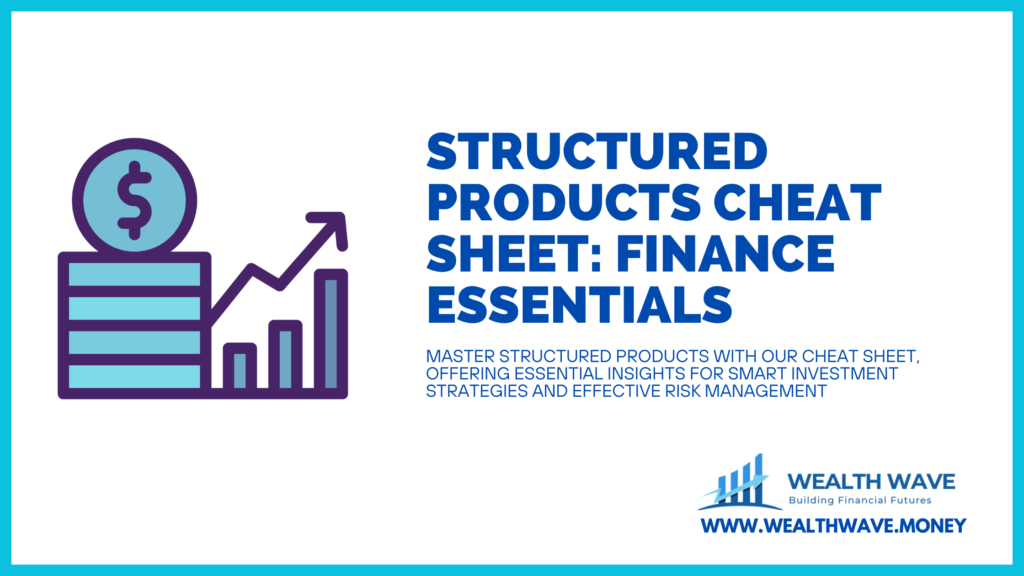
Navigating the world of investment can sometimes feel like wandering through a maze, filled with endless choices and the nagging fear of taking a wrong turn. Believe us, we’ve walked in those shoes and understand that sense of hesitation all too well.
Amidst our quest for the perfect investment opportunity, we stumbled upon something quite intriguing: equity-linked notes (ELNs). What particularly stands out is how these notes use the equity linked note strike price to their advantage.
After pouring over heaps of information, we’ve unearthed some golden nuggets of knowledge.
It turns out, ELNs offer a unique blend of fixed income security with the potential to benefit from stock market performance. One highlight that caught our attention is this idea that at maturity, you could acquire shares at just 90% of their market value thanks to the strike price feature.
Our guide here aims to demystify ELNs and ponder over why they might just be the piece missing in your investment jigsaw puzzle. So buckle up as we bring some much-needed clarity on venturing into ELNs.
Key Takeaways
- Equity-linked notes blend fixed income with potential equity returns, offering a way to earn from stock market performance while having some principal protection.
- The strike price of an ELN is typically set below the spot market price, allowing investors to buy shares at a discount upon maturity. Examples include strike prices set at 90% or 95% of the spot market value.
- Investing in ELNs suits those with a bullish view on selected equities because it provides additional returns based on equity performance and access to shares at lower prices if markets rise above the strike price.
- Risks associated with ELNs include volatility of underlying shares which can lead to potential loss of principal despite the protective features intended to mitigate losses.
- To invest in ELNs, one needs to apply through a financial advisor or institution and thoroughly understand terms like the strike price and its relation to current market values for informed decision-making.
Understanding Equity-Linked Notes

Equity-linked notes offer a unique blend of investment features. These financial instruments give us exposure to the performance of underlying shares while providing fixed income potential.
Definition and Features

Equity-linked notes (ELNs) mix fixed income investments with returns based on the performance of equities. We receive physical delivery of underlying shares at a 90% strike price upon maturity.
The strike price, set as a discount to the spot market price, gives us an opportunity to buy shares at a specified price. ELNs pay a coupon like a bond while also depending on the performance of equities.
This investment product allows us to engage with the market while providing fixed income-like principal protection.
Moreover, investors with a bullish outlook find ELNs appealing. They offer a chance to gain additional returns based on equity performance. The strike price for these notes typically reflects a percentage of the spot market price, often around 95%.
This means we can potentially benefit from equity market upside while having some degree of principal protection. Investing in equity-linked securities allows us to explore diverse income generation strategies.
How ELNs Work

Equity-linked notes (ELNs) are structured investment products that combine features of fixed income investments and equity performance. We earn a coupon similar to a bond while also gaining potential additional returns based on the underlying equity price.
At maturity, we receive physical delivery of shares at a strike price, which has a discount from the spot market price. For example, if the strike price is set at 90%, we can calculate the number of shares by dividing the principal amount of the note by this strike price.
Investors usually choose ELNs with a bullish outlook on selected companies. By investing in these notes, we buy shares at a specified price, often expressed as a percentage of the spot market price, like a 95% strike.
This allows us to benefit from the upside in equity performance while enjoying principal protection similar to that of traditional fixed income investments. Understanding these aspects helps us navigate the complexities of equity-linked securities and their benefits.
Next, we will explore the key components of an equity-linked note.
Components of an Equity-Linked Note

Components of an Equity-Linked Note include key elements that influence its performance. The strike price plays a crucial role in determining potential returns, while the spot market price reflects current equity values.
Equity Linked Note Strike Price
The strike price plays a crucial role in equity-linked notes (ELNs). It is the price at which we can purchase shares of a selected company. Typically, this price is set below the spot market price.
For example, an ELN may have a strike price of 90% of the spot price. This means we can buy shares at a discount when the note matures.
As investors, we need to understand that the strike price affects our potential returns. If the equities perform well, we benefit from both the fixed income aspect and the equity upside.
Furthermore, the strike price serves as a safety net, offering us principal protection while giving us the chance for additional returns based on market performance.
Spot Market Price
The spot market price represents the current market value of the underlying equities for our equity-linked notes (ELNs). This price fluctuates based on demand and supply in the market.
We must consider this price because it directly impacts our investment returns. ELNs have a strike price set at a discount to the spot market price. For example, a strike price might be expressed as 95% of the spot price.
This discount allows us to purchase shares at a lower cost than their current market value.
Understanding the spot market price helps us gauge performance better. It guides us in predicting how our investment might grow or change over time. This knowledge enhances our decision-making process as we invest in ELNs.
Now, we will explore the components of an equity-linked note, starting with the strike price.
Performance of Equities
Equities play a crucial role in equity-linked notes (ELNs). The performance of these underlying shares directly affects our returns. When the equities perform well, we may enjoy higher potential gains.
ELNs allow us to buy shares at a specified strike price, which is usually set at a discount to the spot market price. For example, if we have a 90% strike price, we calculate the number of shares we receive by dividing the principal amount by the strike price.
As investors, our bullish outlook drives the appeal of ELNs. We gain access to physical shares at lower prices if the equities rise above the strike price. This opportunity to invest at a reduced cost adds to our interest.
However, volatility in the underlying shares can impact the overall performance of our investment. We must consider these factors carefully. Let’s explore the benefits of equity-linked notes next.
Benefits of Equity Linked Notes

Equity-linked notes offer a way to earn fixed income while enjoying the potential for extra returns. They help us manage risk and open doors to diverse investment options.
Fixed Income Investment with Additional Returns
Equity-linked notes (ELNs) offer a unique investment opportunity. They combine fixed income investments with potential extra returns linked to the performance of equities. At maturity, we receive physical delivery of underlying shares at a strike price set at a discount to the spot market price.
This means we can enjoy fixed income-like principal protection while benefiting from equity market upside.
Investing in ELNs allows us to generate income while also accessing returns based on the performance of selected equities. The structure of ELNs makes them appealing to investors who expect positive performance in the stock market.
By choosing a strike price, such as 90% of the spot market price, we position ourselves to capitalize on favorable market movements while minimizing risk.
Lower Risk
Equity-linked notes (ELNs) offer lower risk compared to many other investments. They provide fixed income-like principal protection while allowing us to participate in the equity market’s upside.
The strike price typically sits at a discount to the spot market price of the underlying securities. This setup helps us mitigate potential losses. If equities perform well, we benefit.
If they don’t, our principal remains safer due to this protective feature. Such characteristics make ELNs appealing for those looking to balance risk and reward.
Diversification Opportunities
Equity-linked notes (ELNs) offer us valuable diversification opportunities. We can combine fixed income with potential equity returns. Investing in ELNs allows us to access the performance of various equities without putting all our money into individual stocks.
This mix reduces risk by spreading our investments across different assets. For example, a strike price set at a 90% discount to the spot market price can help us acquire shares at a lower cost.
By investing in multiple ELNs, we can enhance our portfolio’s resilience against market fluctuations. The fixed income-like principal protection that ELNs provide allows us to feel secure while we explore the upside potential from equity markets.
Risks of Equity-Linked Notes

Equity-linked notes come with risks, such as the volatility of underlying shares, which can lead to potential loss of principal. We should stay informed about these challenges before investing.
Explore this topic further to better understand how it affects our investment choices.
Volatility of Underlying Shares
Volatility in underlying shares affects the value of equity-linked notes (ELNs). We know that fluctuations in stock prices can lead to significant changes in investment returns. For instance, if the underlying equity performs poorly, it can impact our returns when the ELN matures.
Although we enjoy fixed income-like principal protection, unpredictable movements in share prices can expose us to potential losses.
Investors should consider the price behavior of underlying shares. A high level of volatility means that the market can swing dramatically. This can be both a risk and an opportunity for us.
If we stay bullish on the selected equity, we might benefit from price increases. However, we should also be prepared for the downside risks that come with such volatility.
Potential Loss of Principal
Equity-Linked Notes (ELNs) carry the risk of losing our principal investment. At maturity, we receive physical delivery of shares based on the strike price, which is set at a discount to the spot market price.
If the equities underperform, we may face a loss. The structured nature of ELNs means the potential loss of principal could arise based on the volatility of the underlying shares. We invest in these securities with the expectation of additional returns, but market conditions can change swiftly.
Understanding these risks is crucial as we consider ELNs as a viable investment option.
Next, we will explore how to invest in these products and what steps we need to take.
How to Invest in Equity-Linked Notes

To invest in equity-linked notes, we simply need to apply for an ELN through our financial advisor and closely examine the terms and conditions provided. This process opens doors to new investment opportunities that can enhance our portfolios.
Applying for an ELN
Applying for an Equity-Linked Note (ELN) involves a straightforward process. First, we need to select an ELN that aligns with our investment goals. We can find various offerings that combine fixed income with potential equity returns.
Next, we submit an application through our financial advisor or directly with a financial institution. Each ELN has specific terms and conditions we must understand before committing.
The important details include the strike price and how it relates to the spot market price. For example, if we choose an ELN with a 95% strike price, that means we can purchase shares at a discount relative to the current market.
This opportunity attracts many investors who are bullish on equities. Understanding these components will greatly help us in making informed investment decisions. Now, let’s explore how these components work together in an ELN.
Understanding Terms and Conditions
Understanding the terms and conditions of equity-linked notes (ELNs) is crucial for investors. These structured investment products pay a coupon similar to bonds while linking returns to the performance of equities.
We should know that the strike price typically sits at a discount to the current spot market price of underlying securities. A common example is a 90% strike price, meaning we can buy shares at a lower cost than current market values.
Investors must also understand that ELNs provide principal protection while offering equity market upside. It’s important for us to review any specific tax treatments related to these investments.
By carefully analyzing these terms, we can make informed choices about our investments in equity-linked securities. Next, we will explore the benefits of equity-linked notes.
Conclusion

We have explored the important aspects of equity-linked notes (ELNs) and their strike price. These investment products blend fixed income with potential equity returns. Understanding the strike price helps us assess our investment choices better.
This price often reflects a discount to the market price, which plays a crucial role in our profits. Utilizing ELNs offers us practical benefits like income generation and principal protection.
Let’s take action and consider how ELNs can enhance our investment strategies.
FAQs
Q1. What is an equity-linked note strike price?
Ans. An equity-linked note strike price refers to the predetermined cost at which the underlying security can be bought or sold in derivatives like call options and put options.
Q2. How do exchange-traded securities relate to equity-linked notes?
Ans. Equity-linked notes are a type of exchange-traded securities, where their value is linked to an underlying asset's performance, such as stocks. The strike price plays a crucial role in determining their worth.
Q3. What are reverse equity-linked notes?
Ans. Reverse equity-linked notes are a derivative product that works oppositely from regular ones. Instead of profiting when the linked asset increases, they gain when it decreases.
Q4. How does the strike price affect call and put options within Equity linked Securities?
Ans. In Call option, if actual market prices exceed the set strike price, profits occur while in Put option profit happens when market prices fall below this set rate.




